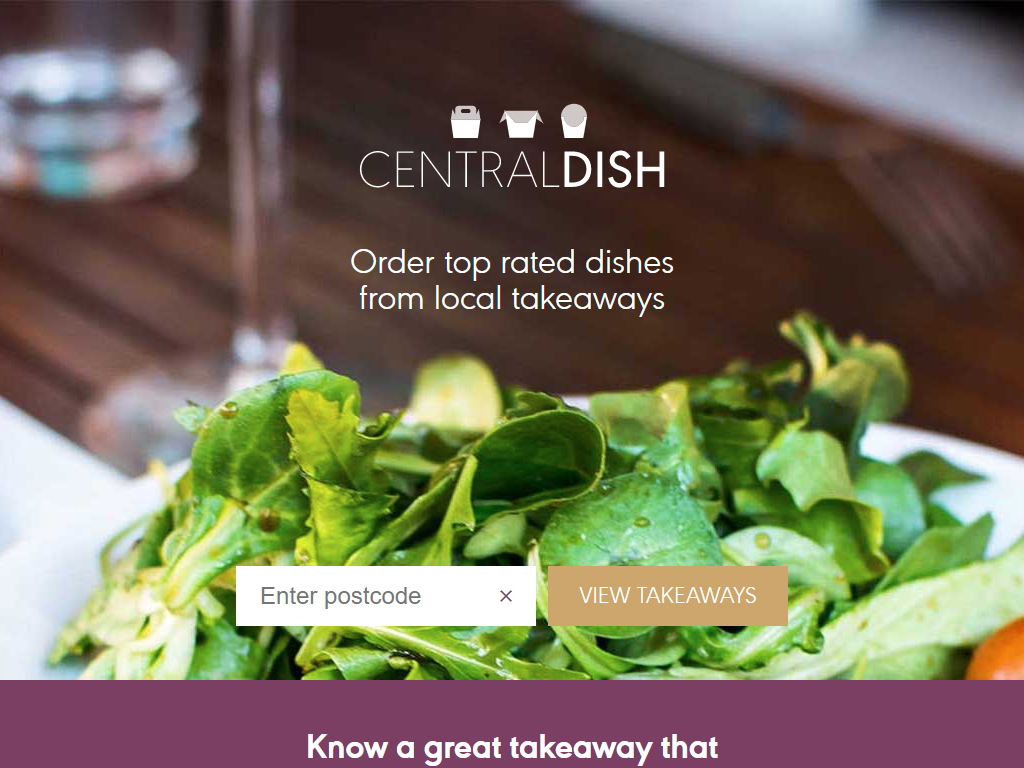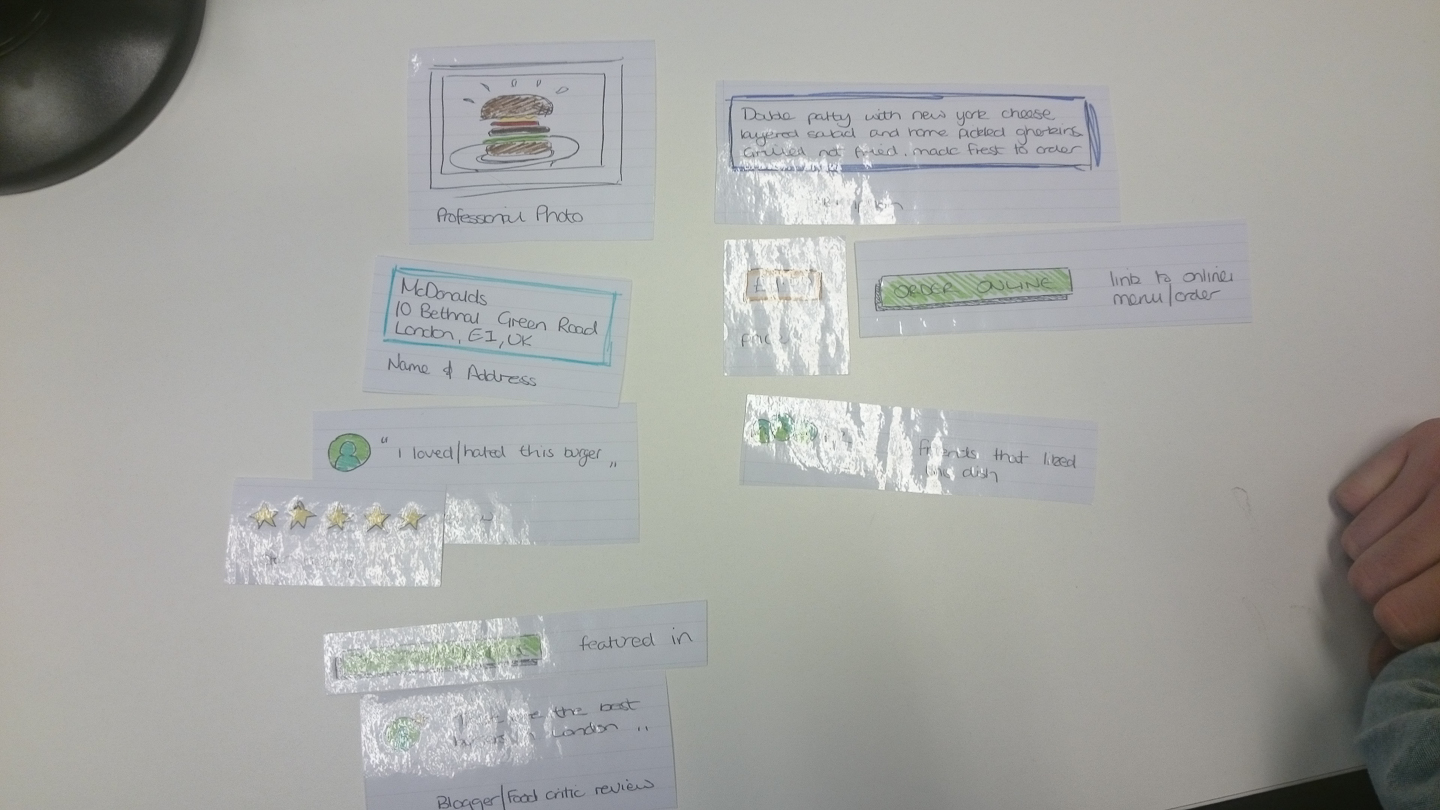
…A look at the methods and outcomes of my discovery work for a product called CentralDish.

The vision
Research
I put in place the companies first formal research programme. By making more informed decisions we could learn and prosper faster than simply competing against luck.

Over 30 interviews
I interviewed over 30 people from a cross-section of personas. These interviews would often be conducted with the sweetener of an included lunch of their choosing in the popular district of Shoreditch where competition in the hospitality sector is fierce.
It allowed me to get a glimpse into people's rationale for ordering food, taking into consideration the bias of the context.

Value and Usability testing
I started with customer development interviews, trying to understand a users job to be done and continued utilising interview processes right up to usability testing on the production site.
I was able to employ various methods from my UX interview playbook including five whys, visual card sorting and monopoly value prioritisation.
Visual card sorting
What and why
Visual card sorting is the addition of lo-fi mock-ups to a card's text description. It's a great technique when you have lots of similar items a normal card sort could not easily differentiate.
How to do it
Armed with a stack of cards I asked users to pick up to 10 items to create a dish information card. After this, I asked the user to remove half to see what was left.
I tallied up the results of both experiments to help give me some quantifiable evidence to support the inclusion and organisation of some data points over others.
Persona Generation and Grouping
Once the first two weeks of user testing had passed I set about creating personas based on the people I had met. These helped me create useful stereotypes that reflected these users personalities, tastes, objectives and obstacles. I created industry-specific measures that helped me communicate how these users would differ from one another when making decisions.
These niche measures captured eating-related traits like a person's group dynamic (were they leaders or followers), their appetite for risk (pun intended) and other behaviours identified as poignant to meal selection.
I also grouped the personas on the wall by the key attributes. This allowed us to see if we targeted a specific behaviour which personas would we serve best as a collective.
As I met with more users and conducted other research, I was able to backfill the persona attributes with data and research to support them. This helped us discover the addressable market and validate our assumptions with academic research papers.

Bespoke demographic data
Persona slogan
Existing solutions
Data
Sketching concepts
Sketching is my go-to way of getting thoughts out of my head and onto screen/paper. They are usually very rough and usually only legible to me in the very first instance. But as an idea begins to take shape so too do my sketches.
I never claim to have the best drawing skills, I only need enough to convey meaning, first to myself and then to my peers. Once everyone has a shared understanding they typically get put to one side and we move on.
Not only is it quick to knock out ideas like this, but it also gives others the confidence to join in. You don't need to be fluent in drawing to sketch out ideas and it's important people don't feel obliged to draw a piece of art each time they want to communicate their idea.
Wireframing
Wireframing isn't a process I use all that often, with design systems I can go from sketch to prototype quickly without the need for these layout UIs.
But in this particular case, I didn't have a design system and I was working alongside a UI designer. I used a very stripped back minimal UI to hand over to the designer. It gave them the remit to design the visual treatments with as much creative freedom as possible, down to the microcopy.





Key findings
Through extensive research, we uncovered some interesting findings that were relevant to our product development.
Breaking bread
Most users expressed the core job to be done was not eating but to spend time with friends or family. Eating is simply a backdrop for this activity.
People love reading the menu
We discovered that users enjoyed salivating over big menus, while they caused friction and even anxiety in the decision-making process it was undeniable that people genuinely enjoyed imagining each dish.
Distance is measured in time
We observed users would describe a restaurant location in terms of time, not distance. We then started framing questions around distance to test the observation. I found that short distances would be described in feet then longer distances were almost exclusively measured in time to the destination.
Food Roulette
We approached the problem of getting interesting meals to users with various unique ideas. One of which was the idea of creating suspense by introducing risk.
The concept came from restaurants in Japan that serve potentially lethal blowfish. People will flock to these eateries where expert chefs prepare the blowfish in such a way it is safe to consume.
Adding risk elevates the experience and provides a variable reward for the user who participates.
For businesses, it's an opportunity to promote a single deal against others in the locality and those can be high margin meal combinations.
Users were split on how they felt on reflection but at the same time demonstrated the kind of hooked behaviour we were looking for.
Warning: A non-numeric value encountered in /home/u158443370/domains/tyfairclough.com/public_html/templates/yootheme/packages/image/src/Image/Listener/LoadImageCover.php on line 26
Warning: A non-numeric value encountered in /home/u158443370/domains/tyfairclough.com/public_html/templates/yootheme/packages/image/src/Image/Listener/LoadImageCover.php on line 26

Warning: A non-numeric value encountered in /home/u158443370/domains/tyfairclough.com/public_html/templates/yootheme/packages/image/src/Image/Listener/LoadImageCover.php on line 26
Warning: A non-numeric value encountered in /home/u158443370/domains/tyfairclough.com/public_html/templates/yootheme/packages/image/src/Image/Listener/LoadImageCover.php on line 26

Warning: A non-numeric value encountered in /home/u158443370/domains/tyfairclough.com/public_html/templates/yootheme/packages/image/src/Image/Listener/LoadImageCover.php on line 26
Warning: A non-numeric value encountered in /home/u158443370/domains/tyfairclough.com/public_html/templates/yootheme/packages/image/src/Image/Listener/LoadImageCover.php on line 26















